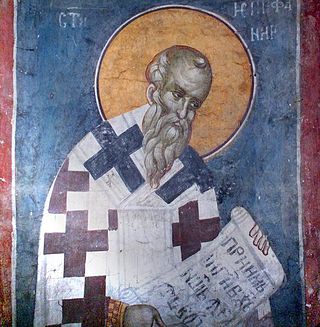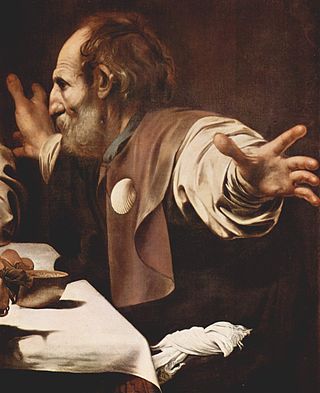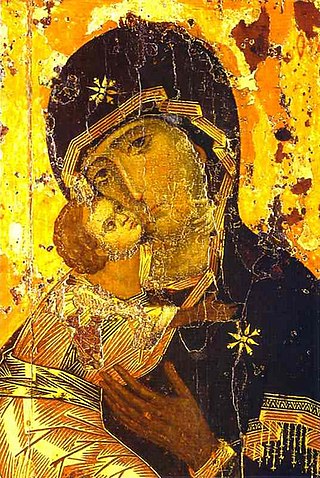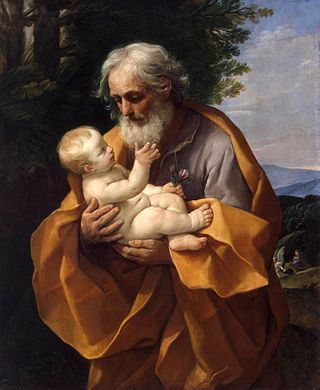Related Research Articles

The Gospel of James is a second-century infancy gospel telling of the miraculous conception of the Virgin Mary, her upbringing and marriage to Joseph, the journey of the couple to Bethlehem, the birth of Jesus, and events immediately following. It is the earliest surviving assertion of the perpetual virginity of Mary, meaning her virginity not just prior to the birth of Jesus, but during and afterwards, and despite being condemned by Pope Innocent I in 405 and rejected by the Gelasian Decree around 500, became a widely influential source for Mariology.

Ebionites as a term refers to a Jewish Christian sect, which viewed poverty as a blessing, that existed during the early centuries of the Common Era. The Ebionites embraced an adoptionist Christology, thus understanding Jesus of Nazareth as a mere man who, by virtue of his righteousness in following the letter and spirit of the Law of Moses, was chosen by God to be the messianic “Prophet like Moses“. A majority of the Ebionites rejected as heresies the orthodox Christian beliefs in Jesus' divinity, pre-existence, virgin birth and substitutionary atonement; and therefore maintained that Jesus was born the natural son of Joseph and Mary, sought to abolish animal sacrifices by prophetic proclamation, and died as a martyr rather than as a substitute for others.
According to the Panarion of Epiphanius of Salamis, and Theodoret's Haereticarum Fabularum Compendium, the Borborites or Borborians were a Christian Gnostic sect, said to be descended from the Nicolaitans. It is difficult to know for sure the practices of the group, as both Epiphanius and Theodoret were opponents of the group. According to Epiphanius, the sect were libertines who embraced the pleasures of the earthly world.

Epiphanius of Salamis was the bishop of Salamis, Cyprus, at the end of the 4th century. He is considered a saint and a Church Father by both the Eastern Orthodox and Catholic Churches. He gained a reputation as a strong defender of orthodoxy. He is best known for composing the Panarion, a compendium of eighty heresies, which included also pagan religions and philosophical systems. There has been much controversy over how many of the quotations attributed to him by the Byzantine Iconoclasts were actually by him. Regardless of this he was clearly strongly against some contemporary uses of images in the church.

James the Just, or a variation of James, brother of the Lord, was a brother of Jesus, according to the New Testament. He was the first leader of the Jerusalem Church of the Apostolic Age. Traditionally, it is believed he was martyred in AD 62 or 69 by being stoned to death by the Pharisees on order of High Priest Ananus ben Ananus. James, Joses, Simon, and Judas are mentioned as the brothers or siblings of Jesus as well as two or more unnamed sisters.

The Nazarenes were an early Jewish Christian sect in first-century Judaism. The first use of the term is found in the Acts of the Apostles of the New Testament, where Paul the Apostle is accused of being a ringleader of the sect of the Nazarenes before the Roman procurator Antonius Felix at Caesarea Maritima by Tertullus. At that time, the term simply designated followers of Jesus of Nazareth, as the Hebrew term נוֹצְרִי, and the Arabic term نَصْرَانِي, still do.
Cerinthus was an early Gnostic, who was prominent as a heresiarch in the view of the early Church Fathers. Contrary to the Church Fathers, he used the Gospel of Cerinthus, and denied that the Supreme God made the physical world. In Cerinthus' interpretation, the Christ descended upon Jesus at baptism and guided him in ministry and the performing of miracles, but left him at the crucifixion. Similarly to the Ebionites, he maintained that Jesus was not born of a virgin, but was a mere man, the biological son of Mary and Joseph.

The brothers of Jesus or the adelphoi are named in the New Testament as James, Joses, Simon, Jude, and unnamed sisters are mentioned in Mark and Matthew. They may have been: (1) the sons of Mary, the mother of Jesus, and Joseph, (2) sons of Mary the wife of Cleophas and sister of Mary, the mother of Jesus; or (3) sons of Joseph by a former marriage. While option 1 is described as the "most natural inference" from the New Testament, those who uphold the perpetual virginity of Mary reject the idea of biological brethren and maintain that the brothers and sisters were either cousins of Jesus or children of Joseph from a previous marriage. The Lutheran Churches have accepted both option 2 and option 3 as being valid explanations for the doctrine of the perpetual virginity of Mary.

Cleopas, also spelled Cleophas, was a figure of early Christianity, one of the two disciples who encountered Jesus during the Road to Emmaus appearance in Luke 24:13–32.

The perpetual virginity of Mary is a Christian doctrine that Mary, the mother of Jesus, was a virgin "before, during and after" the birth of Christ. In Western Christianity, the Catholic Church adheres to the doctrine, as do some Lutherans, Anglicans, Reformed, and other Protestants. The Oriental Orthodox Churches also adhere to this doctrine as part of their ongoing tradition, and Eastern Orthodox churches recognize Mary as Aeiparthenos, meaning "ever-virgin". It is one of the four Marian dogmas of the Catholic Church. Most modern nonconformist Protestants reject the doctrine.

The Gospel of the Ebionites is the conventional name given by scholars to an apocryphal gospel extant only as seven brief quotations in a heresiology known as the Panarion, by Epiphanius of Salamis; he misidentified it as the "Hebrew" gospel, believing it to be a truncated and modified version of the Gospel of Matthew. The quotations were embedded in a polemic to point out inconsistencies in the beliefs and practices of a Jewish Christian sect known as the Ebionites relative to Nicene orthodoxy.
Audianism, or Anthropomorphism, was a sect of Christians in the 4th century in Syria and the Pontic–Caspian steppe, named after its founder Audius or Audaeus, who interpreted the text of the First Epistle to Timothy 3:16 to mean that God created humanity in his image in a literal physical sense.
Collyridianism was an alleged Early Christian movement in Arabia whose adherents apparently worshipped the Virgin Mary, mother of Jesus, as a goddess. The existence of the sect is subject to some dispute by scholars, as the only contemporary source to describe it is the Panarion of St. Epiphanius of Salamis, published in approximately 376 AD.

Jude is one of the brothers of Jesus (Greek: ἀδελφοί, romanized: adelphoi, lit. 'brethren') according to the New Testament. He is traditionally identified as the author of the Epistle of Jude, a short epistle which is reckoned among the seven general epistles of the New Testament—placed after Paul's epistles and before the Book of Revelation—and considered canonical by Christians. Catholics and Eastern Orthodox Christians believe this Jude is the same person as Jude the Apostle; Catholics hold that Jude was a cousin, but not literally a brother of Jesus, while the Eastern Orthodox hold that Jude is St. Joseph’s son from a previous marriage.
In early Christian heresiology, the Panarion, to which 16th-century Latin translations gave the name Adversus Haereses, is the most important of the works of Epiphanius of Salamis. It was written in Koine Greek beginning in 374 or 375, and issued about three years later, as a treatise on heresies, with its title referring to the text as a "stock of remedies to offset the poisons of heresy." It treats 80 religious sects, either organized groups or philosophies, from the time of Adam to the latter part of the fourth century, detailing their histories, and rebutting their beliefs. The Panarion is an important source of information on the Jewish–Christian gospels, the Gospel of the Ebionites, and the Gospel of the Hebrews.

The Elcesaites, Elkasaites, Elkesaites or Elchasaites were an ancient Jewish Christian sect in Lower Mesopotamia, then the province of Asoristan in the Sasanian Empire that was active between 100 and 400 CE. The members of this sect, which originated in the Transjordan, performed frequent baptisms for purification and had a Gnostic orientation.
Lutheran Mariology or Lutheran Marian theology is derived from Martin Luther's views of Mary, the mother of Jesus and these positions have influenced those taught by the Lutheran Churches. Lutheran Mariology developed out of the deep Christian Marian devotion on which Luther was reared, and it was subsequently clarified as part of his mature Christocentric theology and piety. Lutherans hold Mary in high esteem, universally teaching the dogmas of the Theotokos and the Virgin Birth. Luther dogmatically asserted what he considered firmly established biblical doctrines such as the divine motherhood of Mary while adhering to pious opinions of the Immaculate Conception and the perpetual virginity of Mary, along with the caveat that all doctrine and piety should exalt and not diminish the person and work of Jesus Christ. By the end of Luther's theological development, his emphasis was always placed on Mary as merely a receiver of God's love and favour. His opposition to regarding Mary as a mediatrix of intercession or redemption was part of his greater and more extensive opposition to the belief that the merits of the saints could be added to those of Jesus Christ to save humanity. Lutheran denominations may differ in their teaching with respect to various Marian doctrines and have contributed to producing ecumenical meetings and documents on Mary.

Joseph was a 1st-century Jewish man of Nazareth who, according to the canonical Gospels, was married to Mary, the mother of Jesus, and was the legal father of Jesus.
Ebion was the presumed eponymous founder of an early Christian group known as the Ebionites. The existent historical evidence indicates that the name "Ebionite" is derived from a Hebrew word, "ebion" (אביון) meaning "poor" and thus not from someone's name. Ebion is generally seen today as a purely literary figure, whose reputed existence in antiquity was used to explain where the Ebionites got their inspiration. However, once he had been accepted as real, a small tradition developed around him that lasted in early learned Christian circles for a few centuries.
Quintilla was a Phrygian Christian prophetess within the movement known as Montanism. The sect of the Quintillians was named after her.
References
- ↑ Greek ἀντιδικομαριανῖται, literally "opponents of Mary", from ἀντίδικος 'adversary' + Μαρία 'Mary' (OED).
- ↑ Epiphanius uses the term Dimoerite for both the Apollinarians and the Antidicomarians. See Frank Williams (ed.), The Panarion of Epiphanius of Salamis: Books II and III. De Fide, 2nd rev. ed. (Brill, 2013), §§77–78.
- 1 2 3 William H. Brackney, Historical Dictionary of Radical Christianity (Scarecrow Press, 2012 [ ISBN 978-0-8108-7179-3]), p. 31.
- ↑ Petri Luomanen, Recovering Jewish-Christian Sects and Gospels (Brill, 2012), p. 77n.
- ↑ Stephen J. Shoemaker, "Epiphanius of Salamis, the Kollyridians, and the Early Dormition Narratives: The Cult of the Virgin in the Fourth Century", Journal of Early Christian Studies, Vol. 16, No. 3 (2008), pp. 371–401. doi : 10.1353/earl.0.0185
- ↑ Vasiliki Limberis, Divine Heiress: The Virgin Mary and the Making of Christian Constantinople (Routledge, 1994), pp. 119–120.
- ↑ Frank Williams (ed.), The Panarion of Epiphanius of Salamis: Books II and III. De Fide, 2nd rev. ed. (Brill, 2013), §§77–78.
- ↑ Cross, FL, ed. (2005), "Brethren of the Lord", The Oxford Dictionary of the Christian Church, New York: Oxford University Press.
- ↑ Origen (1996). Lienhard, Joseph T. (ed.). Homilies on Luke. The Fathers of the Church Series. Vol. 94. Catholic University of America Press. ISBN 9780813200941.

